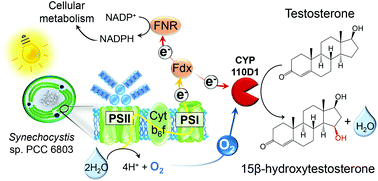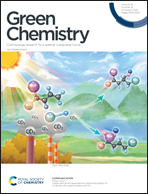Light-driven hydroxylation of testosterone by Synechocystis sp. PCC 6803 expressing the heterologous CYP450 monooxygenase CYP110D1†
Abstract
The selective hydroxylation of steroids through chemical synthesis is a complex reaction with a high environmental impact. The use of photoautotrophic microorganisms expressing heterologous monooxygenases could overcome this problem by fueling the reaction with electrons and O2 derived from the light-dependent oxidation of water, occurring during photosynthesis. Here, the light-driven selective hydroxylation of testosterone into 15β-hydroxytestosterone was achieved using whole-cells of the unicellular cyanobacterium Synechocystis sp. PCC 6803 expressing the heterologous CYP450 monooxygenase, CYP110D1. Additionally, the reaction conditions including cell density, aeration, and substrate concentration were optimized, leading to a maximum specific activity of 1 U gCDW−1. This value is about 2-fold higher than the one achieved using the model heterotrophic bacterium, E. coli, in which was necessary to express not only CYP110D1 but also its electron partners, and to use glucose as a sacrificial electron donor. Altogether, the results obtained here demonstrate the higher efficiency and sustainability (94% atom economy) of testosterone hydroxylation using our engineered Synechocystis chassis, compared to biocatalysis with heterotrophic microorganisms or chemical synthesis.



 Please wait while we load your content...
Please wait while we load your content...